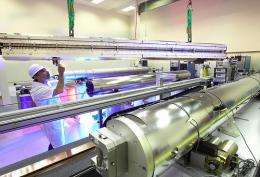A SLAC researcher works on the newly-opened Linac Coherent Light Source. Image courtesy of SLAC.
The recently opened Linac Coherent Light Source (LCLS) at the SLAC National Accelerator Laboratory (SNAL) provides scientists around the world with a brilliant new tool to understand fundamental properties of atoms and materials at previously unreachable dimensions.
Its birth, however, could not have occurred without the expertise of Argonne scientists.
The LCLS is a very powerful example of an X-ray free-electron laser, which comprises a series of magnetic structures called undulators that provide precise magnetic fields through which an electron beam travels. Electrons are forced to oscillate back and forth as they traverse through the undulators, producing large quantities of X-rays. These X-rays then interact with the electrons that generated them, causing the electrons to bunch at particular wavelengths -- this new bunch pattern dramatically boosts the intensity of the produced X-rays.
The precision and stability specifications required of the undulators at LCLS exceed those at Argonne’s own Advanced Photon Source (APS) and other light-source facilities around the world. The pulses of X-ray laser light from LCLS will be shorter than those produced at storage ring sources, resulting in an instantaneous brightness a billion times larger than can be produced by any other X-ray source available now or in the near future.
The LCLS now joins the other DOE light sources: the APS, the Advanced Light Source at Lawrence Berkeley National Laboratory and the National Synchrotron Light Source at Brookhaven National Laboratory. Taken together, they provide the U.S. with a series of state-of-the-art, complementary research tools needed to carry out revolutionary research.
To get to this point, SLAC asked Argonne scientists to help build the undulator system, taking the technology already used at the APS to the next level. "Argonne was tapped to participate in this project because of its expertise with the APS undulators," said J. Murray Gibson, Argonne’s associate laboratory director for photon sciences. "An X-ray laser such as LCLS opens up new scientific frontiers and represents an immense technical achievement for the United States. We could not have done this without the partnership of national laboratories, universities and industry.”
The electron and photon beams within the LCLS undulator must travel on a straight trajectory that can only deviate by a few dozen micrometers. Members of the Argonne Accelerator Systems Division Diagnostics and RF groups, in collaboration with the APS Engineering Support Division Controls and Mechanical Engineering groups and Stanford Linear Accelerator Center scientists, developed a novel technology that provides measurements of the beam trajectory with sub-micron resolution. The information obtained from this monitor is then fed back to the steering magnets controlling the beam as it passes through the undulator.
The undulators themselves were designed and constructed by the Accelerator Systems Division's Magnetic Devices and Accelerator Physics Groups, together with the Mechanical Engineering Group.
“These advanced characteristics will aid scientists in discovering and probing new states of matter, understanding and following chemical reactions and biological processes in real time, imaging chemical and structural properties of materials on the nanoscale, and many new and exciting discoveries we cannot even imagine today,” added Marion White, senior physicist at the APS. “The LCLS will enable revolutionary new science.”
Provided by Argonne National Laboratory
























